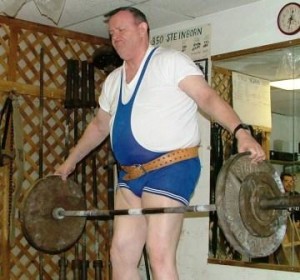Reeves Lift vs. the Rim Lift
By Al Myers
One of the lifts contested this weekend at the Dino Gym Challenge is the Reeves Lift, modeled after a favorite lift of the famous bodybuilder and actor Steve Reeves. He loved this lift as he felt it enhanced his famous lat spread. I recently received an email asking about the required bar length for the Reeves Lift, and asking if a shorter bar could be used. This got me to thinking about the Rules of the Reeves Lift, and how it compares to the IAWA(UK) Lift the Rim Lift. Interestingly, the Reeves Lift is ONLY a USAWA lift while the Rim Lift is ONLY an IAWA(UK) lift with the big difference being the length of bar required. Let’s rehash the rules of each:
RULE FOR USAWA LIFT: Deadlift – Reeves
The rules of the Deadlift apply with these exceptions. The lift starts by the lifter gripping one plate on each side of the bar. The flanges of the plates may be turned outwards to provide a better gripping surface. A regulation bar of legal length must be used. There are no width specifications of the flanges of the lifting plates. Weight is added to the bar with smaller diameter plates so the lifter always has just one plate per side to grip.
RULE FOR IAWA(UK) LIFT: RIM LIFT
The lifter will deadlift, hacklift or straddle a loaded barbell whilst holding only the rims of the discs. The maximum sized discs for the is lift are 18 inches. On the inside the discs must be flat and smooth, and on the outside the rim cannot be deeper than 1inch. The lifter must not grasp any handles, holes or specially prepared areas, only the thumbs on the smooth inside and the fingers on the outside rim. Any bar can be used as the distance between the collars is optional. Whatever style of lift the lifter chooses the lift will always be finished in the correct fashion, with an erect posture. On completion the referee will signal to replace the bar.
Causes for Failure:
The causes for failure for the deadlift, hacklift or straddle will apply, depending on the style elected.
Failure to achieve the correct fully erect finishing posture.
Lowering/replacing the bar before the referees signal.
As you can see these are two completely different lifts, with the Reeves Lift being a much more difficult lift. Now you do have some choices in picking a “good bar” for the Reeves Lift. The USAWA has definite rules for USAWA regulation bars (that hasn’t always been the case however in the earlier days of the USAWA). Looking in the USAWA Rulebook you find these rules as it applies to USAWA regulation bars:
VI. Equipment 16. The bar must meet the following specifications.
- The bar must have a minimum diameter of 25 millimeters or 1 inch.
- The bar must have a maximum diameter of 1.25”.
- The sleeves of the bar must have a minimum diameter of 50 millimeters or 1.96 inches.
- The minimum distance between the inside collars is 51 inches.
- The maximum distance between the inside collars is 58 inches.
- The minimum total length of the bar must not be less than 7 feet. An exception to this is when lifts are done where the combined weight of the bar and the plates does not exceed 20 kilograms or 45 pounds, whereas a lighter and shorter bar may be used. Another exception is allowing a lighter and shorter bar to be used for women, older lifters and junior lifters.
- The maximum total length of the bar must not exceed 8 ½ feet.
- All bars must be marked with a clear indication of the bar’s weight if the bar’s weight is not 45 pounds or 20 kilograms.
- The bar may contain knurling on any parts of it.
- For one hand lifts, the bar must contain knurling in the center of the bar.
- The bar must be straight.
- The sleeves of the bar are allowed to revolve.
So obviously having a bar closer in length to the inside collars of 51 inches is preferred over the maximum distance of inside collars at 58 inches. The GOOD NEWS for the lifters this weekend at the Dino Gym Challenge is that I have made a speciality regulation bar for the Reeves Lift which has a short “collar to collar” length. However, you still need the finger strength to hold onto the plates and this only helps with reaching the plates. Not everyone has the long “wing span” of Tom Ryan!!
